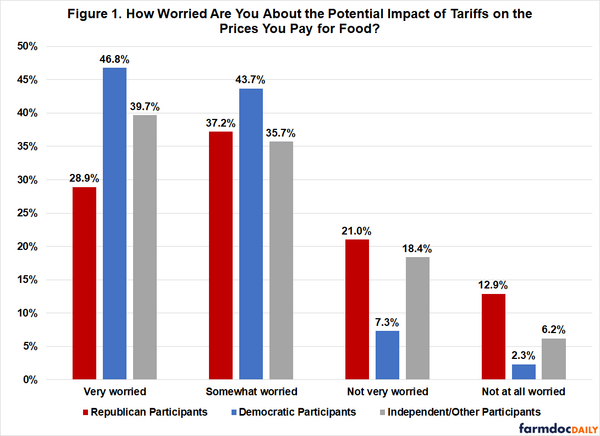 |
|---|
by Maria Kalaitzandonakes and Jonathan Coppess, Department of Agricultural and Consumer Economics, University of Illinois and Brenna Ellison, Department of Agricultural Economics, Purdue University
Grocery stores and gas pumps play an important role in informing consumers’ economic expectations and perceptions of inflation. The impacts are felt in real time, directly, and frequently. While inflationary concerns have been persistent in recent years, this week’s tariffs on key trading partners (Canada, Mexico, and China) have prompted addition concern about prices.
Results from the Gardner Food and Agricultural Policy Survey find that the majority of consumers – across parties – expect tariffs to increase the prices they pay for food. This was highest for Democratic participants (85.4% said they expected food prices to increase) but was also very high for both Republican participants (74.6%) and Independent/Other participants (74.6%).
Similarly, our results show that consumers are bracing for the impact. Just over 77% of participants responded that they are either somewhat or very worried about tariffs, and those who are worried about tariffs’ impacts on food prices are also pessimistic about short-term inflation, expecting inflation to worsen in the next few months.
Finally, we review tracked measures of short-term inflation expectations, highlighting substantial partisan changes across time. Our results show that Republican participants became more optimistic following the election and stayed optimistic in the most recent wave (conducted in February 2025), Democrat participants became somewhat more pessimistic in November and much more pessimistic in the most recent wave, and Independent/Other participants became more optimistic in November but dropped back to pre-election expectations in the most recent wave.
Consumers’ expectations for the economy and inflation have important implications for stakeholders all along the food system. With tariffs now a reality, the Gardner Food and Agricultural Policy Survey will continue to track consumer perceptions and views, adding to a running record soon approaching three years.
To read the entire report click here.




